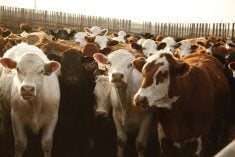REGINA – Farmers in Scotland and Canada share many common experiences, say Scottish Galloway breeders John and Anne Finlay.
The couple was invited to judge the Canadian Western Agribition Galloway show in Regina, where they found the cattle similar in type to those in Scotland. As they met Canadian farmers, they realized they share similar concerns for the future for people on the land.
“There are a lot of cattle and sheep disappearing off the land because of the cost of production,” said Finlay.
Young people are exiting the industry and fewer people are left behind to run the farms.
Read Also

Growth plates are instrumental in shaping a horse’s life
Young horse training plans and workloads must match their skeletal development. Failing to plan around growth plates can create lifelong physical problems.
“It is a big problem with young people leaving the farm. There’s not enough money in farming and young people aren’t getting trained to do the job,” he said.
As they judged the show, they noticed solid black animals are popular in both countries and show ring techniques are also the same.
Showmen like to enhance their animals’ appearance with precision grooming techniques so the Finlays made a point of feeling the animals’ muscle shape and fat cover through the thick, curly hair.
While both are qualified judges, they rarely join each other in the ring.
This time was a new experience with consensus on the winners throughout the different classes.
“And we’re not divorced. It’s surprising we agreed,” said Anne.
For their female champions they selected entries from Diamond B Ranches of Livelong, Sask., and Sawki Ranch of Swift Current, Sask. The grand and reserve bull champions were from Glenfiddich Galloways of Puslinch, Ont., and Diamond B respectively.
The couple grew up raising Galloways and has a herd of 40 purebred cows on their farm in southwestern Scotland. They are also witnessing a resurgence in an old breed developed in Scotland to withstand a harsh climate and limited feed supply.
“They are gaining in popularity. They are easy to feed and produce good beef at a cheap rate,” said John.
However, the plague of disease has taken its toll on the British beef herd.
The British purebred Galloway herd was depleted after the foot-and-mouth outbreak in 2001-02 when thousands of animals were ordered destroyed to quickly eradicate the fast moving, contagious disease.
The outbreak came within eight kilometres of their farm but they did not have to sacrifice any animals.
“A lot of herds were lost. They probably slaughtered too many,” he said.
Before that outbreak and the discovery of BSE in Canada, the Finlays imported cattle from Canada as well as embryos and semen from Australia to introduce new bloodlines.
They bought their last Canadian bull in 2000 at the Agribition sale but since BSE was found in Canada, no live Canadian animals are allowed in Britain.
“It’s political. We should be able to bring live cattle,” he said.















